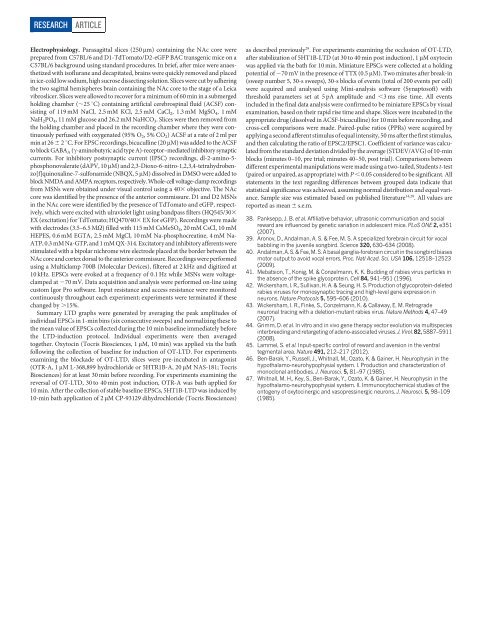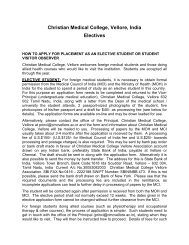Feature Article - Nature Magazine
Feature Article - Nature Magazine
Feature Article - Nature Magazine
You also want an ePaper? Increase the reach of your titles
YUMPU automatically turns print PDFs into web optimized ePapers that Google loves.
RESEARCH<br />
ARTICLE<br />
Electrophysiology. Parasagittal slices (250 mm) containing the NAc core were<br />
prepared from C57BL/6 and D1-TdTomato/D2-eGFP BAC transgenic mice on a<br />
C57BL/6 background using standard procedures. In brief, after mice were anaesthetized<br />
with isoflurane and decapitated, brains were quickly removed and placed<br />
in ice-cold low sodium, high sucrose dissecting solution. Slices were cut by adhering<br />
the two sagittal hemispheres brain containing the NAc core to the stage of a Leica<br />
vibroslicer. Slices were allowed to recover for a minimum of 60 min in a submerged<br />
holding chamber (,25 uC) containing artificial cerebrospinal fluid (ACSF) consisting<br />
of 119 mM NaCl, 2.5 mM KCl, 2.5 mM CaCl 2 , 1.3 mM MgSO 4 ,1mM<br />
NaH 2 PO 4 , 11 mM glucose and 26.2 mM NaHCO 3 .Sliceswerethenremovedfrom<br />
the holding chamber and placed in the recording chamber where they were continuously<br />
perfused with oxygenated (95% O 2 ,5%CO 2 ) ACSF at a rate of 2 ml per<br />
min at 26 6 2 uC. For EPSC recordings, bicuculline (20 mM) was added to the ACSF<br />
to block GABA A (c-aminobutyric acid type A)-receptor–mediated inhibitory synaptic<br />
currents. For inhibitory postsynaptic current (IPSC) recordings, dl-2-amino-5-<br />
phosphonovalerate (dAPV, 10 mM) and 2,3-Dioxo-6-nitro-1,2,3,4-tetrahydrobenzo[f]quinoxaline-7-sulfonamide<br />
(NBQX, 5 mM) dissolved in DMSO were added to<br />
block NMDA and AMPA receptors, respectively. Whole-cell voltage-clamp recordings<br />
from MSNs were obtained under visual control using a 403 objective. The NAc<br />
core was identified by the presence of the anterior commissure. D1 and D2 MSNs<br />
in the NAc core were identified by the presence of TdTomato and eGFP, respectively,<br />
which were excited with ulraviolet light using bandpass filters (HQ545/303<br />
EX (excitation) for TdTomato; HQ470/403 EX for eGFP). Recordings were made<br />
with electrodes (3.5–6.5 MV) filled with 115 mM CsMeSO 4 , 20 mM CsCl, 10 mM<br />
HEPES, 0.6 mM EGTA, 2.5 mM MgCl, 10 mM Na-phosphocreatine, 4 mM Na-<br />
ATP, 0.3 mM Na-GTP, and 1 mM QX-314. Excitatory and inhibitory afferents were<br />
stimulated with a bipolar nichrome wire electrode placed at the border between the<br />
NAc core and cortex dorsal to the anterior commissure. Recordingswere performed<br />
using a Multiclamp 700B (Molecular Devices), filtered at 2 kHz and digitized at<br />
10 kHz. EPSCs were evoked at a frequency of 0.1 Hz while MSNs were voltageclamped<br />
at 270 mV. Data acquisition and analysis were performed on-line using<br />
custom Igor Pro software. Input resistance and access resistance were monitored<br />
continuously throughout each experiment; experiments were terminated if these<br />
changed by .15%.<br />
Summary LTD graphs were generated by averaging the peak amplitudes of<br />
individual EPSCs in 1-min bins (six consecutive sweeps) and normalizing these to<br />
the mean value of EPSCs collected during the 10 min baseline immediately before<br />
the LTD-induction protocol. Individual experiments were then averaged<br />
together. Oxytocin (Tocris Biosciences, 1 mM, 10 min) was applied via the bath<br />
following the collection of baseline for induction of OT-LTD. For experiments<br />
examining the blockade of OT-LTD, slices were pre-incubated in antagonist<br />
(OTR-A, 1 mM L-368,899 hydrochloride or 5HTR1B-A, 20 mM NAS-181; Tocris<br />
Biosciences) for at least 30 min before recording. For experiments examining the<br />
reversal of OT-LTD, 30 to 40 min post induction, OTR-A was bath applied for<br />
10 min. After the collection of stable baseline EPSCs, 5HT1B-LTD was induced by<br />
10-min bath application of 2 mM CP-93129 dihydrochloride (Tocris Biosciences)<br />
as described previously 28 . For experiments examining the occlusion of OT-LTD,<br />
after stabilization of 5HT1B-LTD (at 30 to 40 min post induction), 1 mM oxytocin<br />
was applied via the bath for 10 min. Miniature EPSCs were collected at a holding<br />
potential of 270 mV in the presence of TTX (0.5 mM). Two minutes after break-in<br />
(sweep number 5, 30-s sweeps), 30-s blocks of events (total of 200 events per cell)<br />
were acquired and analysed using Mini-analysis software (Synaptosoft) with<br />
threshold parameters set at 5 pA amplitude and ,3 ms rise time. All events<br />
included in the final data analysis were confirmed to be miniature EPSCs by visual<br />
examination, based on their rapid rise time and shape. Slices were incubated in the<br />
appropriate drug (dissolved in ACSF-bicuculline) for 10 min before recording, and<br />
cross-cell comparisons were made. Paired-pulse ratios (PPRs) were acquired by<br />
applying a second afferent stimulus of equal intensity, 50 ms after the first stimulus,<br />
and then calculating the ratio of EPSC2/EPSC1. Coefficient of variance was calculated<br />
from the standard deviation divided by the average (STDEV/AVG) of 10-min<br />
blocks (minutes 0–10, pre trial; minutes 40–50, post trial). Comparisons between<br />
different experimental manipulations were made using a two-tailed, Students t-test<br />
(paired or unpaired, as appropriate) with P , 0.05 considered to be significant. All<br />
statements in the text regarding differences between grouped data indicate that<br />
statistical significance was achieved, assuming normal distribution and equal variance.<br />
Sample size was estimated based on published literature 14,28 . All values are<br />
reported as mean 6 s.e.m.<br />
38. Panksepp, J. B. et al. Affiliative behavior, ultrasonic communication and social<br />
reward are influenced by genetic variation in adolescent mice. PLoS ONE 2, e351<br />
(2007).<br />
39. Aronov, D., Andalman, A. S. & Fee, M. S. A specialized forebrain circuit for vocal<br />
babbling in the juvenile songbird. Science 320, 630–634 (2008).<br />
40. Andalman, A. S. & Fee, M. S. A basal ganglia-forebrain circuit in the songbird biases<br />
motor output to avoid vocal errors. Proc. Natl Acad. Sci. USA 106, 12518–12523<br />
(2009).<br />
41. Mebatsion, T., Konig, M. & Conzelmann, K. K. Budding of rabies virus particles in<br />
the absence of the spike glycoprotein. Cell 84, 941–951 (1996).<br />
42. Wickersham, I. R., Sullivan, H. A. & Seung, H. S. Production of glycoprotein-deleted<br />
rabies viruses for monosynaptic tracing and high-level gene expression in<br />
neurons. <strong>Nature</strong> Protocols 5, 595–606 (2010).<br />
43. Wickersham, I. R., Finke, S., Conzelmann, K. & Callaway, E. M. Retrograde<br />
neuronal tracing with a deletion-mutant rabies virus. <strong>Nature</strong> Methods 4, 47–49<br />
(2007).<br />
44. Grimm, D. et al. In vitro and in vivo gene therapy vector evolution via multispecies<br />
interbreeding and retargeting of adeno-associated viruses. J. Virol. 82, 5887–5911<br />
(2008).<br />
45. Lammel, S. et al. Input-specific control of reward and aversion in the ventral<br />
tegmental area. <strong>Nature</strong> 491, 212–217 (2012).<br />
46. Ben-Barak, Y., Russell, J., Whitnall, M., Ozato, K. & Gainer, H. Neurophysin in the<br />
hypothalamo-neurohypophysial system. I. Production and characterization of<br />
monoclonal antibodies. J. Neurosci. 5, 81–97 (1985).<br />
47. Whitnall, M. H., Key, S., Ben-Barak, Y., Ozato, K. & Gainer, H. Neurophysin in the<br />
hypothalamo-neurohypophysial system. II. Immunocytochemical studies of the<br />
ontogeny of oxytocinergic and vasopressinergic neurons. J. Neurosci. 5, 98–109<br />
(1985).



